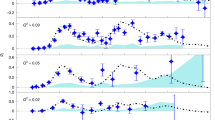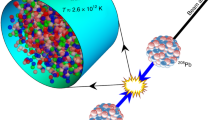Abstract
According to quantum chromodynamics, vacuum is not an empty space, because it is filled with quark–antiquark pairs. The pair has the same quantum numbers as the vacuum and forms a condensate because the strong interaction of the quantum chromodynamics is too strong to leave the vacuum empty. This quark–antiquark condensation, the chiral condensate, breaks the chiral symmetry of the vacuum. The expectation value of the chiral condensate is an order parameter of the chiral symmetry, which is expected to decrease at high temperatures or high matter densities where the chiral symmetry is partially restored. Head-on collisions of nuclei at ultra-relativistic energies have explored the high-temperature regime, but experiments at high densities are rare. Here we measure the spectrum of pionic 121Sn atoms and study the interaction between the pion and the nucleus. We find that the expectation value of the chiral condensate is reduced at finite density compared to the value in vacuum. The reduction is linearly extrapolated to the nuclear saturation density and indicates that the chiral symmetry is partially restored due to the extremely high density of the nucleus.
This is a preview of subscription content, access via your institution
Access options
Access Nature and 54 other Nature Portfolio journals
Get Nature+, our best-value online-access subscription
$29.99 / 30 days
cancel any time
Subscribe to this journal
Receive 12 print issues and online access
$209.00 per year
only $17.42 per issue
Buy this article
- Purchase on Springer Link
- Instant access to full article PDF
Prices may be subject to local taxes which are calculated during checkout



Similar content being viewed by others
Data availability
Raw data were generated at the RI Beam Factory. Source data are provided with this paper.
Code availability
The computer codes used to generate results are available from the corresponding author upon reasonable request.
References
Weise, W. Nuclear aspects of chiral symmetry. Nucl. Phys. A 553, 59–72 (1993).
Brown, G. E. & Rho, M. Chiral restoration in hot matter. Phys. Rep. 269, 333–380 (1996).
Higgs, P. W. Broken symmetries and the masses of gauge bosons. Phys. Rev. Lett. 13, 508–509 (1964).
DeTar, C. E. & Heller, U. M. QCD thermodynamics from the lattice. Eur. Phys. J. A 41, 405–437 (2009).
Fu, W. J., Pawlowski, J. M. & Rennecke, F. QCD phase structure at finite temperature and density. Phys. Rev. D. 101, 054032 (2020).
Stock, R. (ed.) Relativistic Heavy Ion Physics. Landolt-Börnstein Group I Elementary Particles, Nuclei and Atoms Vol. 23 (Springer, 2010).
Fukushima, K. & Hatsuda, T. The phase diagram of dense QCD. Rep. Prog. Phys. 74, 014001 (2010).
Friman, B. et al. (ed.) The CBM Physics Book: Compressed Baryonic Matter in Laboratory Experiments. Lecture Notes in Physics Vol. 814 (Springer, 2011).
Muto, R. et al. Evidence for in-medium modification of the meson at normal nuclear density. Phys. Rev. Lett. 98, 042501 (2007).
Kim, H. J. & Gubler, P. The ϕ meson with finite momentum in a dense medium. Phys. Lett. B 805, 135412 (2020).
Jido, D., Hatsuda, T. & Kunihiro, T. In-medium pion and partial restoration of chiral symmetry. Phys. Lett. B 670, 109–113 (2008).
Klimt, S., Lutz, M., Vogl, U. & Weise, W. Generalized SU(3) Nambu-Jona-Lasinio model. Nucl. Phys. A 516, 429–468 (1990).
Nagahiro, H., Jido, D., Fujioka, H., Itahashi, K. & Hirenzaki, S. Formation of η′(958)-mesic nuclei by the (p, d) reaction. Phys. Rev. C 87, 045201 (2013).
Friedman, E. & Gal, A. The pion-nucleon σ term from pionic atoms. Phys. Lett. B 792, 340–344 (2019).
Ajimura, S. et al. "K−pp", a K−-meson nuclear bound state, observed in 3He(K−, Λp)n reactions. Phys. Lett. B 789, 620–625 (2019).
Yamaga, T. et al. Observation of a \({\bar{K}NN}\) bound state in the 3He(K−, Λp)n reaction. Phys. Rev. C 102, 044002 (2020).
Ishikawa, T. et al. Low-energy scattering parameters between the η meson and nucleon from η photoproduction on the deuteron. Acta Phys. Pol. B 48, 1801–1806 (2017).
Tanaka, Y. K. et al. Measurement of excitation spectra in the 12C(p, d) reaction near the η′ emission threshold. Phys. Rev. Lett. 117, 202501 (2016).
Suzuki, K. et al. Precision spectroscopy of pionic 1s states of Sn nuclei and evidence for partial restoration of chiral symmetry in the nuclear medium. Phys. Rev. Lett. 92, 072302 (2004).
Gilg, H. et al. Deeply bound π− states in 207Pb formed in the 208Pb(d, 3He) reaction. I. Experimental method and results. Phys. Rev. C 62, 025201 (2000).
Itahashi, K. et al. Deeply bound π− states in 207Pb formed in the 208Pb(d, 3He) reaction. II. Deduced binding energies and widths and the pion-nucleus interaction. Phys. Rev. C 62, 025202 (2000).
Ericson, M. & Ericson, T. E. O. Optical properties of low-energy pions in nuclei. Ann. Phys. 36, 323–362 (1966).
Batty, C., Friedman, E. & Gal, A. Strong interaction physics from hadronic atoms. Phys. Rep. 287, 385–445 (1997).
Friedman, E. & Gal, A. In-medium nuclear interactions of low-energy hadrons. Phys. Rep. 452, 89–153 (2007).
Yamazaki, T. et al. Discovery of deeply bound π− states in the 208Pb(d, 3He) reaction. Z. Phys. A 335, 219–221 (1996).
Geissel, H. et al. Experimental indication of a reduced chiral order parameter from the 1s π− state in 205Pb. Phys. Lett. B 549, 64–71 (2002).
Yamazaki, T., Hirenzaki, S., Hayano, R. S. & Toki, H. Deeply bound pionic states in heavy nuclei. Phys. Rep. 514, 1–87 (2012).
Tomozawa, Y. Axial-vector coupling constant renormalization and the meson-baryon scattering lengths. Nuovo Cim. A 46, 707–717 (1966).
Weinberg, S. Pion scattering lengths. Phys. Rev. Lett. 17, 616–621 (1966).
Kolomeitsev, E., Kaiser, N. & Weise, W. Chiral dynamics of deeply bound pionic atoms. Phys. Rev. Lett. 90, 9–12 (2003).
Friedman, E. et al. Elastic scattering of low energy pions by nuclei and the in-medium isovector πN amplitude. Phys. Rev. C 72, 034609 (2005).
Kubo, T. In-flight RI beam separator BigRIPS at RIKEN and elsewhere in Japan. Nucl. Instrum. Methods Phys. Res. B 204, 97–113 (2003).
Ohya, S. Nuclear data sheets for A = 121. Nucl. Data Sheets 111, 1619–1806 (2010).
Nishi, T. et al. Spectroscopy of pionic atoms in 122Sn(d, 3He) reaction and angular dependence of the formation cross sections. Phys. Rev. Lett. 120, 152505 (2018).
Nishi, T. et al. BigRIPS as a high resolution spectrometer for pionic atoms. Nucl. Instrum. Methods Phys. Res. B 317, 290–293 (2013).
Fujita, H. et al. Realization of matching conditions for high-resolution spectrometers. Nucl. Instrum. Methods Phys. Res. A 484, 17–26 (2002).
Ikeno, N., Yamagata-Sekihara, J., Nagahiro, H. & Hirenzaki, S. Formation spectra of pionic atoms in the Green’s function method. Prog. Theor. Exp. Phys. 2015, 033D01 (2015).
Szwec, S. V. et al. Neutron occupancies and single-particle energies across the stable tin isotopes. Phys. Rev. C 104, 054308 (2021).
Friedman, E. & Gal, A. Renormalization of the isovector πN amplitude in pionic atoms. Nucl. Phys. A 724, 143–156 (2003).
Fricke, G. et al. Nuclear ground state charge radii from electromagnetic interactions. Data Nucl. Data Tables 60, 177–285 (1995).
Terashima, S. et al. Proton elastic scattering from tin isotopes at 295 MeV and systematic change of neutron density distributions. Phys. Rev. C. 77, 024317 (2008).
Ficenec, J. R., Fajardo, L. A., Trower, W. P. & Sick, I. Elastic electron-tin scattering. Phys. Lett. B 42, 213–215 (1972).
Nose-Togawa, N., Nagahiro, H., Hirenzaki, S. & Kume, K. Residual interaction effects on deeply bound pionic states in Sn and Pb isotopes. Phys. Rev. C 71, 061601 (2005).
Hirenzaki, S., Toki, H. & Yamazaki, T. (d, 3He) reactions for the formation of deeply bound pionic atoms. Phys. Rev. C 44, 2472–2479 (1991).
Hirtl, A. et al. Redetermination of the strong-interaction width in pionic hydrogen. Eur. Phys. J. A 57, 70 (2021).
Chanfray, G., Ericson, M. & Oertel, M. In-medium modification of the isovector pion-nucleon amplitude. Phys. Lett. B 563, 61–67 (2003).
Hübsch, S. & Jido, D. Density dependence of the quark condensate in isospin-asymmetric nuclear matter. Phys. Rev. C 104, 015202 (2021).
Kaiser, N., De Homont, P. & Weise, W. In-medium chiral condensate beyond linear density approximation. Phys. Rev. C 77, 025204 (2008).
Goda, S. & Jido, D. Chiral condensate at finite density using the chiral Ward identity. Phys. Rev. C 88, 065204 (2013).
Lacour, A., Oller, J. A. & Meißner, U.-G. The chiral quark condensate and pion decay constant in nuclear matter at next-to-leading order. J. Phys. G 37, 125002 (2010).
Ikeno, N. et al. Precision spectroscopy of deeply bound pionic atoms and partial restoration of chiral symmetry in medium. Prog. Theor. Phys. 126, 483–509 (2011).
Acknowledgements
We thank the staff of the RI Beam Factory for stable operation of the facility. This experiment was performed at the RI Beam Factory, operated by RIKEN Nishina Center and CNS, University of Tokyo. This work is partly supported by the MEXT Grant-in-Aid for Scientific Research on Innovative Areas (nos. JP22105517, JP24105712 and JP15H00844 to K.I.), JSPS Grant-in-Aid for Scientific Research (B) (nos. JP16340083 and JP18H01242 to K.I.), (A) (no. JP16H02197 to K.I. and T.U.) and (C) (nos. JP16K05355 and JP24540274 to S.H.), Grant-in-Aid for Early-Career Scientists (no. JP19K14709 to N. Ikeno), Grant-in-Aid for JSPS Research Fellow (no. JP12J08538 to T.N.), JSPS Fund for the Promotion of Joint International Research (Fostering Joint International Research (B); no. JP20KK0070 to K.I.), Institute for Basic Science (IBS-R031-D1 to D.A.), the Bundesministerium für Bildung und Forschung (H.G., E.H. and H.W.), the National Science Foundation through grant no. Phys-0758100, and the Joint Institute for Nuclear Astrophysics (grants nos. Phys-0822648 and PHY-1430152; JINA Center for the Evolution of the Elements to G.P.A.B.).
Author information
Authors and Affiliations
Consortia
Contributions
T.N. and K.I. designed the experimental concepts and performed experiments, developed detectors and ion optics, analysed data, performed theoretical calculations, and wrote the paper. G.P.A.B., M.D., H.F., N. Fukuda, N. Fukunishi, H.G., E.H., K. Kusaka, N.S., H.S., K.S., H.T., Y.K.T., T.U., Y.W. and H.W. developed the ion optics and performed experiments. S.H. and N. Ikeno designed experimental concepts, performed theoretical calculations and wrote the paper. N.N.-T. performed theoretical calculations and wrote the paper. H.M. developed the detectors. H.N. and M.I. designed the experimental concepts. All other authors performed experiments.
Corresponding author
Ethics declarations
Competing interests
The authors declare no competing interests.
Peer review
Peer review information
Nature Physics thanks Paul Indelicato and the other, anonymous, reviewer(s) for their contribution to the peer review of this work.
Additional information
Publisher’s note Springer Nature remains neutral with regard to jurisdictional claims in published maps and institutional affiliations.
Source data
Source Data Fig. 2
Measured spectra data in Figure 2.
Rights and permissions
Springer Nature or its licensor (e.g. a society or other partner) holds exclusive rights to this article under a publishing agreement with the author(s) or other rightsholder(s); author self-archiving of the accepted manuscript version of this article is solely governed by the terms of such publishing agreement and applicable law.
About this article
Cite this article
Nishi, T., Itahashi, K., Ahn, D. et al. Chiral symmetry restoration at high matter density observed in pionic atoms. Nat. Phys. 19, 788–793 (2023). https://doi.org/10.1038/s41567-023-02001-x
Received:
Accepted:
Published:
Issue Date:
DOI: https://doi.org/10.1038/s41567-023-02001-x
This article is cited by
-
Modified in medium
Nature Physics (2023)
-
Experimental Study of In-medium Spectral Change of Vector Mesons at J-PARC
Few-Body Systems (2023)



